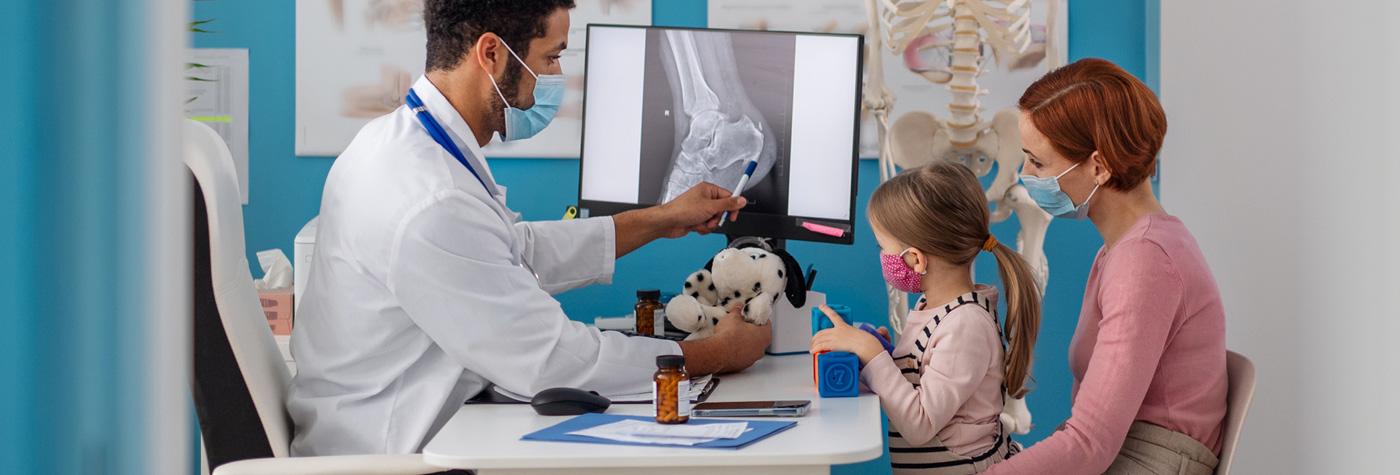Helping Your Child Prepare for an X-Ray
For a child, having any medical experience can be scary. Children cope better and express less fear if they know what to expect before any medical intervention. Caregivers can use the information below to help their child understand what happens when getting an X-ray.
What is an X-ray?
An X-ray is a medical diagnostic test that uses a specialized camera to take pictures of the inside of the body. X-ray imaging tests use a small amount of radiation to more easily see the insides of the body. The X-ray radiation will not hurt your child and does not stay in your child’s body after the exam.
X-rays help doctors diagnose a wide variety of injuries and illnesses. X-rays can be used to check bones for fractures, to diagnose and monitor diseases, and to locate foreign objects.
Doctors use many different types of X-ray tests to photograph different areas of the body. Some exams require consumable contrast materials that enhance visibility. Depending on exam requirements, contrast materials may be received orally, rectally or intravenously. Contrast materials do not produce radiation and will later be absorbed or excreted by the body.
Check with your child’s doctor to find out the exact type of X-Ray procedure your child will undergo so you can help them understand what will be required.
Describing X-ray equipment
X-ray equipment can be intimidating to a child due to its size, but it is made up of smaller pieces they will find familiar.
Most equipment includes a large tube with a flat screen (containing the “camera”) and a table on which a child can sit or lie. Sometimes X-rays can be taken while a child is standing up.
The tube and screen will be moved so that it lines up with the body part needing to be photographed. The camera does not need to touch your child’s body to take the X-ray.
The person who takes the X-ray picture is called a technologist. The technologist will help guide you and your child during the X-ray procedure.
Preparing for an X-ray
Your child should wear comfortable, loose-fitting clothing for their X-ray. For some X-ray tests, your child may be asked to change into a special hospital gown.
It is always best to remove any jewelry, hearing aids, non-permanent retainers, and/or hair pins prior to an X-ray. Ask the technologist about any other metal items that your child may be wearing so that they do not affect the X-ray images.
Taking the X-ray
Most of the time, caregivers are encouraged to stay close to their child during an X-ray to help them feel more comfortable. The technologist will ask any caregivers staying in the X-ray room during the picture to wear the lead apron to protect them from the radiation.
It is recommended that caregivers who are or may be pregnant leave the room during an X-ray. Please share this information with the technologist to keep you and your child safe.
The technologist may place protective coverings on your child during the X-ray to protect other areas of their body from the radiation. The small amount of radiation from an X-ray will not hurt your child, but having a neck covering or heavy blanket on your child will provide extra protection.
The technologist will help your child get ready for the X-ray by telling them how to stand, sit or lay down. Your child may have some straps placed on the part of their body being photographed. The strap will be similar to a seatbelt.
The technologist will need to place your child in the correct position to take the pictures. Sometimes, if your child has an injury, these positions may make them feel uncomfortable. The technologist will help your child find the most comfortable position possible to make sure the X-ray produces high-quality images that can improve their quality of care. The technologist may take multiple pictures and may need to move your child’s body to see different areas of their body.
Once your child is positioned, the technologist will go behind a window or step out of the room to take the X-ray picture. The technologist will only leave for a few seconds to take the picture, and your child will be visible to them at all times.
When it is time to take a picture, the technologist will ask your child to hold still (play “Freeze”) and may have them hold their breath. It is important that your child stay as still as possible so the pictures are not blurry.
Producing X-ray pictures can take a little as five minutes depending on the number of images that are needed.
After the X-ray
The technologist will help your child exit from the equipment once the imaging is complete. A radiologist (a doctor who specializes in looking at and reading radiology images) will look at the X-ray pictures and give a report to your child’s doctor. You will receive results from your child’s doctor.
After an X-ray exam, your child should be able return to their normal activities as instructed by your child’s doctor.

